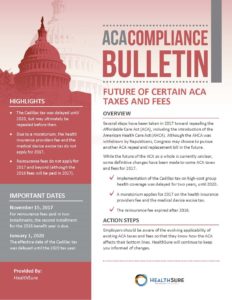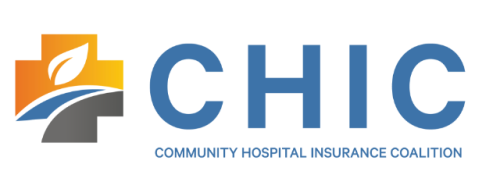Contents
House Republicans Pass Amended AHCA
Future of Certain ACA Taxes and Fees
5 Ways to Cut Your Health Care Costs
Cost-saving Strategy: Generic Drugs
Did you know? State Innovation Waiver
House Republicans Pass Amended AHCA

Overview
On May 4, 2017, members of the U.S. House of Representatives voted 217-213 to pass the American Health Care Act (AHCA), after it had been amended several times. The AHCA is the proposed legislation to repeal and replace the Affordable Care Act (ACA).
The AHCA needed 216 votes to pass in the House. Ultimately, it passed on a party-line vote, with 217 Republicans and no Democrats voting in favor of the legislation. The AHCA will only need a simple majority vote in the Senate to pass.
If it passes both the House and the Senate, the AHCA would then go to President Donald Trump to be signed into law.
Impact on Employers
The AHCA will now move on to be considered by the Senate. It is likely that the Senate will make changes to the proposed legislation before taking a vote. The AHCA would only need a simple majority vote in the Senate to pass.
However, unless the AHCA is passed by the Senate and signed by President Trump, the ACA will remain intact.
Legislative Process
The AHCA is budget reconciliation legislation, so it cannot fully repeal the ACA. Instead it is limited to addressing ACA provisions that directly relate to budgetary issues—specifically, federal spending and taxation. A full repeal of the ACA must be introduced as a separate bill that would require 60 votes in the Senate to pass.
Since the AHCA was introduced, it has been amended several times. To address concerns raised by both Democrats and fellow Republicans, the House Republican leadership released amendments to the legislation on March 20, 2017, followed by a second set of amendments on March 23, 2017. On March 23, 2017, House leadership withdrew the AHCA before taking a vote. After the withdrawal, Republicans made additional amendments (the MacArthur amendments) to the AHCA, followed by a separate corrective amendment. A new House vote was scheduled for May 4, 2017, which resulted in a 217 to 213 vote to pass the AHCA.
The AHCA will now move on to be considered by the Senate. It is likely that the Senate will make changes to the proposed legislation before taking a vote. The AHCA would only need a simple majority vote in the Senate to pass. However, unless the AHCA is passed by the Senate and signed by President Trump, the ACA will remain intact.
ACA Provisions Not Impacted
The majority of the ACA would not be affected by the AHCA. The MacArthur amendments specifically maintain most of the ACA’s market reforms. For example, the following key ACA provisions would remain in place:
- Cost-sharing limits on essential health benefits (EHBs) for non-grandfathered plans (currently $7,150 for self-only coverage and $14,300 for family coverage)
- Prohibition on lifetime and annual limits for EHBs
- Requirements to cover pre-existing conditions
- Coverage for adult children up to age 26
- Guaranteed availability and renewability of coverage
- Nondiscrimination rules (on the basis of race, nationality, disability, age or sex)
- Prohibition on health status underwriting
Age rating restrictions would also continue to apply, with the age ratio limit being revised to 5:1 (instead of 3:1), and states would be allowed to set their own limits. The MacArthur amendments also reinstate EHBs as the federal standard, eliminating a prior controversial amendment to the AHCA, although states may obtain waivers from these rules.
Repealing the Employer and Individual Mandates
The ACA imposes both an employer and individual mandate. The AHCA would reduce the penalties imposed under these provisions to zero beginning in 2016, effectively repealing both mandates (although they would technically still exist).
However, beginning with open enrollment for 2019, the AHCA would allow issuers to add a 30 percent late-enrollment surcharge to the premium cost for any applicants that had a lapse in coverage for greater than 63 days during the previous 12 months. The late-enrollment surcharge would be discontinued after 12 months.
Replacing Health Insurance Subsidies with Tax Credits
The ACA currently offers federal subsidies in the form of premium tax credits and cost-sharing reductions to certain low-income individuals who purchase coverage through the Exchanges. The AHCA would repeal both of these subsidies, effective in 2020, and replace them with a portable, monthly tax credit for all individuals that could be used to purchase individual health insurance coverage.
The AHCA would also repeal the ACA’s small business tax credit beginning in 2020. In addition, under the AHCA, between 2018 and 2020, the small business tax credit generally would not be available with respect to a qualified health plan that provides coverage relating to elective abortions.
State Waivers
The MacArthur amendments include an option for states to obtain limited waivers from certain federal standards, in an effort to lower premiums and expand the number of insured. Under this option, states could apply for waivers from the ACA’s EHB requirement and community rating rules, except that states could not allow rating based on:
- Gender;
- Age (except for reductions in the 5:1 ratio already included by the AHCA); or
- Health status (unless the state established a high-risk pool or is participating in a federal high-risk pool)
To receive the waiver, states would need to attest that the purpose of the waiver is to reduce premium costs, increase the number of individuals with health coverage or advance another benefit to the public interest in the state (including guaranteed coverage for individuals with pre-existing condition exclusions).
State Stability Fund
The last set of corrective amendments to the AHCA establishes a Patient and State Stability Fund for 2018 through 2023. This fund is intended to provide an additional $8 billion to states that have applied for, and been granted, a waiver from community rating, as specified by the MacArthur amendments.
The funds would be required to be used in “providing assistance to reduce premiums or other out-of-pocket costs” of individuals who may be subject to an increase in their monthly premium rates because they:
- Reside in a state with an approved waiver;
- Have a pre-existing condition;
- Are also uninsured because they have not maintained continuous coverage; and
- Purchase health care in the individual market.
Enhancements to Health Savings Accounts (HSAs)
HSAs are tax-advantaged savings accounts tied to a high deductible health plan (HDHP), which can be used to pay for certain medical expenses. To incentivize use of HSAs, the AHCA would:
- Increase the maximum HSA contribution limit: The HSA contribution limit for 2017 is $3,400 for self-only coverage and $6,750 for family coverage. Beginning in 2018, the AHCA would allow HSA contributions up to the maximum out-of-pocket limits allowed by law (at least $6,550 for self-only coverage and $13,100 for family coverage).
- Allow both spouses to make catch-up contributions to the same HSA: The AHCA would allow both spouses of a married couple to make catch-up contributions to one HSA, beginning in 2018, if both spouses are eligible for catch-up contributions and either has family coverage.
- Address expenses incurred prior to establishment of an HSA: Under the AHCA, starting in 2018, if an HSA is established within 60 days after an individual’s HDHP coverage begins, the HSA funds would be able to be used to pay for expenses incurred starting on the date the HDHP coverage began.
Relief from ACA Tax Changes
The AHCA would provide relief from many of the ACA’s tax provisions. The amendments made to the AHCA accelerated this relief by one year for most provisions, moving the effective dates for repeal up to 2017. The affected tax provisions include the following:
- Cadillac tax: The ACA imposes a 40 percent excise tax on high cost employer-sponsored health coverage, effective in 2020. The AHCA would change the effective date of the tax, so that it would apply only for taxable periods beginning after Dec. 31, 2025.
- Restrictions on using HSAs for over-the-counter (OTC) medications: The ACA prohibits taxpayers from using certain tax-advantaged HSAs to help pay for OTC medications. The AHCA would allow these accounts to be used for OTC purchases, beginning in 2017.
- Increased tax on withdrawals from HSAs: Distributions from an HSA (or Archer MSA) that are not used for qualified medical expenses are includible in income and are generally subject to an additional tax. The ACA increased the tax rate on distributions that are not used for qualified medical expenses to 20 percent. The AHCA would lower the rate to pre-ACA percentages, beginning with distributions in 2017.
- Health flexible spending account (FSA) limit: The ACA limits the amount an individual may contribute to a health FSA to $2,500 (as adjusted each year). The AHCA would repeal the limitation on health FSA contributions for taxable years beginning in 2017.
- Additional Medicare tax: The ACA increased the Medicare tax rate for high-income individuals, requiring an additional 0.9 percent of wages, compensation and self-employment income over certain thresholds to be withheld. The AHCA would repeal this additional Medicare tax beginning in 2023.
- Deduction limitation for Medicare Part D subsidy: The ACA eliminated the ability for employers receiving the retiree drug subsidy to take a tax deduction on the value of this subsidy. Effective in 2017, the AHCA would repeal this ACA change and reinstate the business-expense deduction for retiree prescription drug costs without reduction by the amount of any federal subsidy.
Beginning after Dec. 31, 2016, the AHCA would also repeal the medical devices excise tax, the health insurance providers fee and the fee on certain brand pharmaceutical manufacturers. The 10 percent sales tax on indoor tanning services would be repealed effective June 30, 2017, to reflect the quarterly nature of this collected tax. Finally, the AHCA would also reduce the medical expense deduction income threshold to 5.8 percent (lower than the pre-ACA level of 7.5 percent), beginning in 2017.
Modernize Medicaid
The AHCA would repeal the ACA’s Medicaid expansion, and make certain other changes aimed at modernizing and strengthening the Medicaid program. The amendments to the AHCA made a number of modifications to the proposed Medicaid changes. For example, the AHCA would provide enhanced federal payments to states that already expanded their Medicaid programs, and then transition Medicaid’s financing to a “per capita allotment” model starting in 2020, where per-enrollee limits would be imposed on federal payments to states. It would also allow states the option to implement a work requirement for nondisabled, nonelderly, nonpregnant adults as a condition for receiving Medicaid coverage.
The AHCA would also modernize Medicaid’s data and reporting systems, repeal the ACA’s disproportionate share hospital (DSH) cuts and make changes to the process for eligibility determinations.
Future of Certain ACA Taxes and Fees
Overview
Several steps have been taken in 2017 toward repealing the Affordable Care Act (ACA), including the introduction of the American Health Care Act (AHCA).
Although the AHCA was withdrawn by Republicans, Congress may choose to pursue another ACA repeal and replacement bill in the future.While the future of the ACA as a whole is currently unclear, some definitive changes have been made to some ACA taxes and fees for 2017.
- Implementation of the Cadillac tax on high-cost group health coverage was delayed for two years, until 2020.
- A moratorium applies for 2017 on the health insurance providers fee and the medical device excise tax.
- The reinsurance fee expired after 2016.
Action Steps
Employers should be aware of the evolving applicability of existing ACA taxes and fees so that they know how the ACA affects their bottom lines. HealthSure will continue to keep you informed of changes.
Important Dates
- November 15, 2017 For reinsurance fees paid in two installments, the second installment for the 2016 benefit year is due.
- January 1, 2020 The effective date of the Cadillac tax was delayed until the 2020 tax year.
5 Ways to Cut Your Health Care Costs
Cost-saving Strategy: Generic Drugs
Generic drugs can sometimes be misunderstood as subpar or not up to the same quality standards as name-brand prescription drugs. This is unfortunate because generic drugs are not only of the same high quality as name-brand prescriptions, but they usually cost much less (80-85 percent less).
According to the Food and Drug Administration (FDA), generic medications save $3 billion every week and more than $150 billion annually.
Boosting the use of generic medications by educating employees about generic drugs can potentially save you and your employees significant money.
To maximize generic use, keep employees up to date on the newest approved generic medications through this FDA resource or by utilizing the FDA’s Orange Book, which allows you to search for generic drugs based on a variety of characteristics.
Earlier this year, the Department of Health and Human Services (HHS) sent a letter to state governors to highlight Section 1332 of the Affordable Care Act (ACA). Beginning in 2017, Section 1332 allows states to apply for a State Innovation Waiver from certain ACA requirements.
These waivers are intended to allow states the flexibility to pursue innovative strategies for providing their residents with access to high quality, affordable health insurance, while retaining the basic protections of the ACA.





